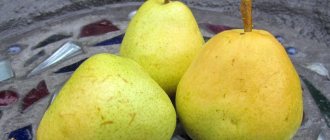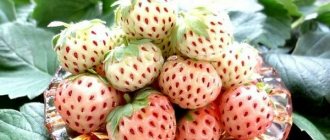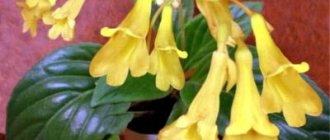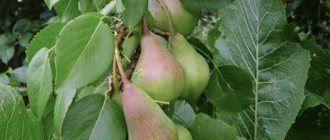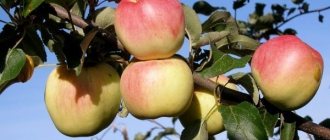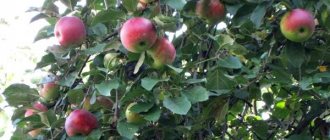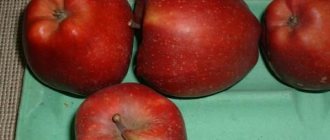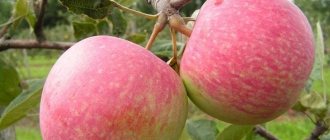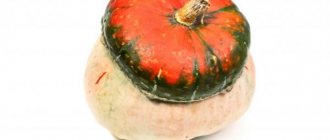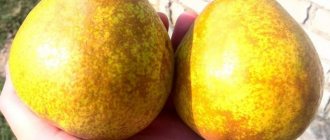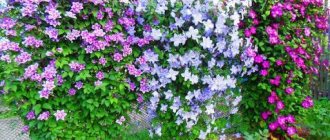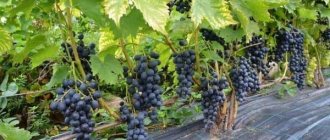The Aport apple tree is popular all over the world. This is one of the largest-fruited and valuable varieties, the merits of which have been repeatedly confirmed at numerous exhibitions.
Apples are often called souvenir apples: their external showiness is combined with an excellent wine-sweet-sour taste that meets high tasting standards
The main characteristics of the Aport apple variety are given in the table:
| Parameter | Characteristic |
| Culture | Apple tree (Malus domestica Borch.) |
| Variety type | "Aport" |
| Tree height | Tall: about 6 m |
| Precociousness | Average - 7-8 years after planting |
| Terms of removable (technical) maturity | 2nd half of September – early October |
| Period of consumption/shelf life of fruits | Winter; apples last 4-6 months |
| Type of fruiting | Mixed |
| Productivity of one tree | Up to 150 kg |
| Size and weight of fruits | Large – 200-250 g |
| Shape and color | Apples are truncated-conical or wide-conical in shape. The peel is strong, smooth, medium thin. The main color is light yellow or greenish-yellow, the outer color is dark red with subcutaneous white dots |
| Fruit pulp | Juicy, crumbly, tender, fine-grained with a pronounced aroma |
| Tasting assessment (taste qualities) | 4.6-5 points (out of 5) – sweet-sour-wine taste |
| Purpose of fruits | Dining room (universal) |
| Sustainability | Average winter hardiness, immunity to scab |
| Lifespan | 50 years |
| Year of inclusion in the State Register of the Russian Federation | 2018 (“Aport ACC”) |
| Recommended growing regions | North Caucasian |
| Originators | FGBNU "North Caucasus Federal Scientific Center for Horticulture, Viticulture, Winemaking" (Krasnodar), FGBNU "Federal Scientific Center named after. I. V. Michurina" (Tambov region) |
History of variety development
Almost modern varieties of apple trees originate from the wild Sivers apple tree, which is found only in the foothills of Alatau. It was from her, according to the testimony of many experts, that Aport originated back in the 12th century. Over the past centuries, many clones of this variety have been created, but the first apple trees of the Aport variety, bred centuries ago, stopped growing long ago.
Interesting!
Official sources contain information that this variety of apples was grown in the gardens of the Kingdom of Poland and was distinguished by its late fruit ripening.
It is also known that this variety was brought from the Ottoman Empire, and in Europe these apple trees felt comfortable, so they grew quickly, and over time the fruits became very large - and all thanks to the climate suitable for these apple trees. Thanks to its positive qualities, this fruit tree quickly became popular among gardeners not only in Poland, but also in other European countries.
Photo of the Aport apple tree
Two centuries ago, Aport seedlings were brought to Germany, where the first clone of this variety was bred, which was named Alexander - in honor of Emperor Alexander 1
. This clone quickly spread throughout Europe, and its seedlings were brought to the USA. And in America, this clone was among the best hybrid varieties of apple trees that were grown in the country for industrial purposes.
Although in recent decades new varieties of these fruit trees have been bred, distinguished by improved characteristics, and over time replacing the Aporta Alexander clone, many gardeners still dream of planting this particular variety in their garden.
But currently only clones of the Aport culture are sold on the market for these fruit trees.
The most famous of them, besides Alexander, is the Alma-Ata Aport, which in the last decades of the last century was the hallmark of Kazakhstan - its large, juicy apples were quickly sold out in the markets of Almaty, and guests of the capital of Kazakhstan took them with them. However, Alma-Ata Aport was quite capricious to growing conditions and could only be grown in mountainous areas at an altitude of 900 to 1200 meters above sea level.
When grown in lower areas, the fruits overgrow, and in higher places, apples do not contain enough sugars. But at present, Alma-Ata Aport is grown only by dedicated specialists in Kazakhstan nurseries.
Origin
Note that the first mentions of this variety can be found in historical chronicles as far back as the 12th century. It is currently not possible to establish the exact origin of the Aport apple tree; the evidence from different sources varies too much.
Some scientists believe that the variety was imported from the Ottoman Empire, others believe that from Poland, there are also opinions about Ukrainian, Russian and Kazakh “citizenship”. At this point in time, the variety is found on all five inhabited continents of the earth.
Interesting: there are references dating back to 1779: in these references A.T. Bolotov calls the Aport variety “Gusevsky”.
Aport was bred from several varieties of apple trees. Interestingly, there are currently several varieties of this apple tree that have characteristics similar to Aport, obtained using its genetic material.
There is an opinion among fairly authoritative botanists that in our time it is almost impossible to find pure Aport - all apple trees grown under this name are simply varieties of the variety.
In particular these are:
- Aport Almaty;
- Huge;
- Ukrainian;
- Blood red;
- Bely et al.
Apple tree Aport: description of the variety and main characteristics
This article will talk about the most popular clone of the Aport apple tree - Alexandra, which in its characteristics and description is practically no different from the “parent” variety.
Apple tree Aport blood red. Brief overview, description - video
Apple trees of this variety are distinguished by medium growth vigor - they reach a height of 5 m. The crown of the tree has a flattened-oval shape, it is of medium density, skeletal branches grow in an average number, they are well developed. The diameter of the crown of Aporta Alexander is about 10 m; this tree grows wider than it is tall. Fruits appear on ringlets and fruit twigs.
The foliage is medium in size, typical of apple trees - slightly elongated, with a sharp tip, slightly wrinkled, bright emerald color.
Interesting!
The ripe fruits of this variety are easily recognizable. Thanks to its positive characteristics, Aport always receives prizes at various international exhibitions, and this variety is popularly nicknamed “souvenir”.
Aport Alexander apples are large and very large - from 230 to 270 g, but fruits weighing 500 g are not uncommon
. The fruits are oblate-conical, with ribbing clearly visible on many apples.
The skin is quite thin, yellow or greenish-yellow in color, but half of the apple is covered with streaks of a rich dark red hue. The peel is oily, rough to the touch, covered with a waxy coating and has a characteristic gloss. On the surface of the skin there are a large number of subcutaneous freckles of white or greenish color.
The taste of ripe fruits of Aport and its clones is excellent - experts claim that the taste of these apples is the best of all varieties and gave it a score of 5 points.
The pulp is dense, juicy, fine-grained, white in color with a greenish tint. The taste of Aport apples is wine-sweet, with a pleasant apple aroma.
The harvested crop is of universal use; it is used for fresh food and is also processed.
Juice, homemade wine and jam are especially tasty. You can add apples to fruit salads, prepare other sweets, and dry them. Moreover, dried apples of this variety are distinguished by their excellent appearance and taste, without changing their appearance during drying.
The harvest is taken from the Aporta trees in the last ten days of September, then they lie in appropriate conditions for another 25-30 days, gaining the appropriate taste
. Apples can be transported over any distance without spoiling or losing their presentation.
On a note!
The collected Aport fruits are stored for a long time - at least six months, while their taste and appearance remain unchanged.
Characteristic
The characteristics of the Lobo apple tree are typical for a representative of medium-sized trees. Its crown is medium in size, rounded and not thickened. The branches grow parallel to the ground, they are powerful, but very flexible. Flowering is abundant, long lasting, the inflorescences are white and pink.
The fruits are round-conical, large, crimson almost over the entire area. The thin skin is slightly bluish, with white dots visible. The fruits are very beautiful and retain their presentation for a long time. The photo shown is a Lobo apple, just taken from the tree.
Tasting assessment
Lobo apples differ not only in external characteristics, but also in taste. The pulp is quite dense, but at the same time tender and juicy. The taste is more sweet, the taste is very interesting, caramel. Light sourness only adds charm.
Fruits of the Lobo apple tree.
The composition of the fruit is also noteworthy. They contain many useful substances, including ascorbic acid, but also a lot of sugars. Apples are used to make sweets and are loved fresh. This is because the organoleptic rating of the fruit 4.8 points out of 5 is simply a wonderful result.
Pollinators
The Lobo variety is not self-pollinating and requires the company of pollinators. There are several varieties of apple trees that are perfect for this:
- Green May;
- Martovskoe;
- Spartacus;
- Mac;
- Orlik.
However, some others will do as well.
It is important that the apple trees bloom at the same time as the Lobo. The distance from neighboring apple trees should be no more than 50 meters
Crown height and diameter
The Lobo apple tree is medium-sized, but grows quite intensively in the first years. To keep the crown round, pruning will be needed. Due to the fact that the apple tree has sparse branches, the fruits ripen well, because they fully receive sunlight. The leaves are ovoid, large, wrinkled, matte.
Productivity
It is worth noting the productivity of this variety. It is high. Fruit ripening occurs annually, without rest stops and cyclicality. The tree is resistant to cold, so it bears fruit in almost any climatic conditions. The apple tree has a tendency to rapidly regenerate, so it is not afraid of diseases and harsh winters.
Beginning of fruiting
The Lobo apple variety is quite fast-growing, so the first fruits can be harvested within three years after planting. You will have to wait six years to get vaccinated, but it is definitely worth it.
Lobo apple harvest.
Ripening time
Lobo apples, like all winter apples, are most delicious at the first frost. However, you need to remove them a little earlier to prepare them for storage. Therefore, depending on the growing region, harvesting occurs at the end of September or beginning of October. The shelf life of apples is about three months.
Winter hardiness
The variety has enviable winter hardiness. Lobo doesn't need cover in almost any region. And even if it partially freezes, it is easily and quickly restored.
But you should know that winter hardiness of the variety is possible only under healthy tree conditions. But with immunity it’s a little more complicated, it’s not that high. Therefore, it will be necessary to regularly carry out preventive measures to prevent the emergence of diseases.
Apple tree productivity
Fruiting of apple trees of the Aport Alexander variety begins late - the first harvest appears 6-7 years after planting the seedlings in a permanent place.
The yield of this variety is high - 140-150 kg of ripe products are collected from one mature tree. However, Aport apple trees have irregular fruiting - good harvests from these fruit trees are harvested once every two seasons.
Good varieties of apple trees:
Summer apple tree Augusta Apple tree Gala Apple tree Sinap Orlovsky
Peculiarities
A distinctive feature of this variety is the size of the fruits, whose average weight is 300 g , but there are often cases when the tree produces a harvest of half a kilogram apples. This is a high-yielding variety suitable for growing in climate zones with moderate winters.
The variety is not resistant to such common diseases as scab and moniliosis. Therefore, for successful growth it is necessary to carry out preventive measures against diseases and pests. The fruits tolerate transportation well and are stored for quite a long time if storage conditions are met.
Aport is a winter apple variety, just like Antonovka.
Tree height
Aport is a medium-sized variety, as it grows up to 5-6 m in height.
Crown width
The crown grows powerful, branched , and reaches 10-12 m in width.
Productivity
Aport has fairly high yields - a mature tree at the peak of fruiting produces about 150 kg.
Tasting assessment
The taste of the fruits of the Aport variety is sweet and sour, with a wine aftertaste . Tasting score 4.6-5.0 points.
Frost resistance
Aport does not tolerate frost very well, so it is recommended for cultivation in regions with moderate winter temperatures.
However, it should be noted that in the process of spreading the variety, varieties were developed .
These varieties of apple trees were better adapted to the conditions of frosty winters.
Self-fertility
This variety can be grown without pollinators, but this will result in reduced yield. Therefore, if possible, it is better to plant a suitable pollinator nearby.
Timing of flowering and harvesting of apples
This variety blooms in June with delicate white flowers. Aport is a late variety - harvesting begins in late September or early October.
Pollination
The following varieties of apple trees are best suited as pollinators: Shield, Pamyat Esaul, Prikubanskoye.
Dimensions
The fruits grow very large, weighing 270 - 300 g, although fruits weighing up to 600 g are not uncommon. The shape of the fruit is round, slightly flattened . The skin is medium thick, slightly oily, red-green in color with yellow spots. The pulp is white, medium density, crumbly.
Beginning of fruiting
Aport is distinguished by a fairly rapid onset of fruiting - most often the first harvest appears 4-5 years after planting the seedling. However, the variety bears fruit periodically - once every two years.
We also recommend that you read materials about other interesting varieties - Berkutovskoe, Grushovka, Konfetnoe, etc.
Diseases and pests
The immunity of these trees is low, so apple trees are often affected by scab and moniliosis.
Therefore, for prevention, it is recommended to treat trees with Bordeaux mixture or copper sulfate in early spring, before the appearance of young leaves, and in the fall after leaf fall.
It is also necessary to remove rotten apples and weeds from tree trunks during the season, and in the fall to collect all fallen leaves after leaf fall and dig up the soil without breaking the clods. In this case, all the pests, their larvae, hidden in the soil for the winter, will freeze.
Advantages and disadvantages
The main and undeniable advantages of the Aport variety include:
- high productivity of mature trees;
- good presentation and excellent taste of Aport apples;
- large-fruited and attractive appearance of ripe fruits;
- the collected fruits tolerate transportation well over long distances and can be stored in appropriate conditions for up to 6 months;
- ripe fruits are distinguished by their versatility;
- The period of active fruiting of these apple trees is about 40 years.
The Aport apple tree also has disadvantages, and you need to remember them:
- planted apple trees begin to bear fruit late - approximately 7-8 years after planting;
- Fruiting in Aport is unstable - abundant harvests are collected every couple of seasons;
- Cold resistance of this variety is average. Therefore, in the Black Earth regions it tolerates winters well and does not freeze, but in the middle zone and other areas with similar climatic conditions, trees need to be covered before the onset of cold weather;
- Also, the Aport variety has low resistance to many diseases characteristic of apple trees, in particular to scab and moniliosis. Therefore, regular spraying of these crops with appropriate preparations for prevention is required, which is quite problematic due to the large height and width of the crown.
Due to such disadvantages, Aport Alexander is grown less and less on an industrial scale, but gardeners still grow this fruit tree on their plots.
Suitable region and climate
The Aport apple tree variety is intended for regions with not too cool winter temperatures. This apple tree does not tolerate severe frosts, so it is not suitable for cultivation in the north. Note, however, that some clones and varieties of Aporta have quite high frost resistance.
And since the variety is not resistant to cold, in our country it is grown only in the south, as well as in the Black Earth Region, in some areas of the middle zone - where the climate is milder. In Ukraine, the Aport variety is distributed throughout almost the entire territory.
Apple tree Aport: planting seedlings
If gardeners decide to plant aport apple trees on their plots, then they need to choose the right tree seedlings, as well as decide on a suitable place for growing.
Is it possible to grow the famous Aport Almaty in the Moscow region? - video
Selection of planting material
Seedlings for planting the Aport apple tree must be purchased only from nurseries or trusted companies that sell similar material. Otherwise, there is a high probability of coming across unscrupulous traders who, instead of one variety, may sell a completely different one.
It is better to purchase two-year-old trees that can easily be transplanted from one place to another (unlike older seedlings). Such plants should have at least 2 branches extending from the main trunk at an angle of 60-90 degrees.
You should also carefully examine the roots - they should be moist and elastic, about 0.4 m long, with no signs of damage or disease. The trunk should also not have growths or other signs of damage. Under the bark, healthy wood is green in color. Saplings are purchased with swollen buds, but without blossoming foliage.
How to choose a landing site for Aport
This apple tree, like most other fruit trees, loves well-lit areas, protected from gusts of cold winds. This variety should not be planted in lowlands, wetlands or in areas where groundwater comes closer to the surface of the earth than 1-1.3 meters.
Advice!
If the groundwater level is too high, a layer of drainage should be placed at the bottom of the planting hole, and the plant should be raised above the soil level.
Seedlings are most often sent from a nursery with a closed root system, so planting such trees is easier, they do not require pre-planting preparation and take root in a new location faster.
Before planting, apple tree seedlings with bare roots should be placed in a bucket of water to which a growth stimulator - Kornevin or Heteroauxin - has been added.
Stages of planting an Aport apple tree:
- The pit for planting is prepared in advance - at least 6 months before the intended planting. The diameter of such a pit is 1 m, and the depth is also 1 m.
- The top layer of excavated garden soil is mixed with 10 kg of river sand, the same amount of compost, 0.8 kg of wood ash and complex mineral fertilizer for fruit trees.
- Before planting, a mound is made of soil in the center of the hole, next to which a metal or wooden stake is driven in, to which the seedling will need to be tied.
- The tree itself is placed on a mound, and the roots are spread along the slopes of the hill. Then fill the hole with a nutrient substrate on top, shaking the tree periodically so that there are no voids in the soil.
- After planting, water is poured into each trunk circle until it stops being absorbed into the soil.
- The tree trunk circle is covered with a layer of mulch 5 cm thick on top; a mixture of peat and humus should be used as a mulching substance.
Further care for the Aport apple tree
Further care for the apple tree includes:
- Regular watering, which is carried out every 3-4 days in an amount of 10 liters. In hot weather, the amount of watering is increased.
- After each watering, it is recommended to loosen the tree trunk circles, while simultaneously removing weeds.
- The layer of mulch in the tree trunk circles should be periodically updated. The thickness of such a layer should be at least 4 cm, and its composition may include cow manure, sawdust or mowed grass.
Feeding fruit trees
Fertilizers should be applied to the Aport apple tree in spring and autumn. During these periods, it is recommended to apply fertilizers containing large amounts of nitrogen to the tree trunk circles.
In autumn, it is better to apply nitrogen-containing fertilizers no later than the first ten days of September.
During the budding period, liquid fertilizer is applied to each Aport apple tree, which is prepared as follows: 100 g of phosphorus and 70 g of potassium fertilizers are added to a bucket of water and mixed thoroughly. And first, 5 kg of cow manure and 2 kg of bird droppings are added to the tree trunk circle, and then the prepared mineral fertilizer is poured.
During the period of ovary formation, 0.5 kg of nitrophoska and 1 g of sodium humate are diluted in 10 liters of water and poured under one tree.
Pruning apple tree Aport
2 or 3 seasons after planting the Aport apple tree, the first pruning of the tree is carried out in the spring before the buds begin to bloom. At the same time, all shoots that grow inside the crown are removed, and old, dried and damaged shoots are also removed. The cutting areas should be treated with garden varnish.
Features of growing the variety in the regions
Moscow region
To grow Aport in the Moscow region, you need to use a species zoned for this. In care, special attention should be paid to feeding and caring for the root zone - regular loosening to improve aeration and water permeation.
Ural and Siberia
The climate of the Urals and Siberia is difficult for large-fruited apple trees; in order to get a harvest in this climatic zone, you can use winter-hardy rootstocks or grow them on stylets
Ukraine
Blood-red Aport and Dubrovsky Aport are successfully grown in Ukraine. The classic algorithm for caring for this tree is suitable for this zone.
Altai
To successfully cultivate Aport in this zone, you can use dwarf and semi-dwarf rootstocks, which have better adaptive characteristics than the classic pure variety. Careful care is required during the period of flowering and budding - at this time, the feeding scheme is of particular importance.
Aport is a very ancient variety; it embodies the history of fruit growing and is part of it. Reviving it in its pure form is a huge painstaking work that gardeners are still doing. We can find varieties of the variety, but Aport Alexander himself is still lost.
We can only hope that in a few decades we will again be able to proudly say that the famous Aport has settled in our garden!
Apple tree Aport: reviews from gardeners
Olga, 44 years old, Ulyanovsk region: For a long time I tried to purchase seedlings of the Aport variety for planting in the garden plot, finally, they sent me two trees of this variety. I planted them according to all the rules, and covered the seedlings with spruce branches for the winter so that they would not freeze. For several years my trees grew and gained strength. And only after 5 years the first fruits appeared on them. True, there were few of them, but each weighed at least 400 g. Subsequently, the yield of these trees became almost as high as stated in the annotation for the variety. They made juice and jam from the fruits, and some were left for eating during the winter. And I sold about half of the harvest in the fall and early winter - these apples were snapped up as quickly as possible. I recommend everyone to grow this late variety of apples on their plot.
Natalya, 50 years old, Samara region: The Aport apple tree has been growing for me for a long time - about 20 years old, it was planted by my parents. I can say that with regular application of fertilizers, timely watering and treatments against diseases and pests, the Aport apple variety produces good yields. And the apples are truly wonderful - large, juicy, sweet and aromatic, Aport has excellent taste.
It is far from easy to grow a tall and powerful tree of this variety in a summer cottage. However, if you follow all the rules of planting and further care, then after several seasons it is quite possible to obtain large harvests of large and juicy apples of the Aport variety.
